“Ice cream 'could be as addictive as cocaine',” reported the Daily Mail. In a bid to scoop its rivals, the newspaper claimed that new research had whipped up “concerns that the dessert could be genuinely addictive”.
It’s not clear who exactly had these chilling “concerns” over the possible addictive qualities of the frozen snack, but the study in question looked at measures of brain activity in 151 teenagers while they drank an ice cream milkshake. During the scans, teenagers who had frequently eaten ice cream over the past two weeks showed less activity in the “reward areas” of the brain that give pleasurable sensations. This reduced reward sensation was reported to be similar to what is seen in drug addiction as users become desensitised to drugs.
Unsurprisingly, the study did not directly compare brain responses to or cravings for ice cream with those for illegal drugs. Therefore, while some aspects of the brain’s response may be similar, it is not correct to say that this study has found that ice cream is “as addictive” as illegal drugs.
It should be noted that the study included only healthy teenagers of normal weight, and its results may not represent overweight or older people. It also only tested one food, so the results may not apply to other foods.
Where did the story come from?
The study was carried out by researchers from the Oregon Research Institute in the US. Sources of funding were not clear. The study was published in the peer-reviewed American Journal of Clinical Nutrition.
The newspapers focused on the suggestion that ice cream is “as addictive” as drugs. However, it is not possible to conclude this from the study.
What kind of research was this?
This experimental study looked at whether regularly eating ice cream reduces the brain’s pleasurable “reward” response. When we do things that support our survival, such as eating and drinking, the brain gives us a pleasurable reward sensation, reinforcing this behaviour and encouraging it in future. A similar process is also believed to occur in drug addiction, where a person’s reward response to the drug decreases with repeated exposure, leading to a need to take more of the drug.
The researchers reported that people who are obese experience less of a response to food in the reward centres of the brain, which may contribute to over-eating. Repeatedly eating foods with high levels of calories (called “energy dense” foods has also been shown to lead to brain changes that reduce reward response in rats. The researchers wanted to see if a similar thing happens in humans, by looking at whether regularly eating ice cream reduces the brain’s pleasurable reward response to an ice cream milkshake.
What did the research involve?
The researchers recruited 151 adolescent volunteers who were not overweight. They asked them how often they ate ice cream, and carried out brain scans while they drank either a tasteless solution or an ice cream milkshake. They then looked at whether the volunteers who ate ice cream frequently showed less brain activity in the reward centres of the brain when drinking the ice cream milkshake.
The study excluded any individuals who were overweight or had reported binge eating in the past three months, as well as any who had used illegal drugs, took certain medications, had a head injury or a mental health diagnosis in the last year. The volunteers completed standard food questionnaires about their eating habits over the past two weeks, including how often they ate ice cream. They also answered questions about food cravings and how much they liked certain foods, including ice cream. The volunteers also had their weight, height and body fat measured.
Volunteers were asked to eat their meals as usual but not to eat anything for five hours before the brain scan. The researchers then gave them either a sip of chocolate ice cream milkshake or a tasteless solution, and monitored the activity in their brain. Each participant received both drinks in a randomised order. The researchers then looked at what happened in the brain during each drink, and whether this varied depending on how much ice cream the volunteer usually ate. They also looked at whether body fat or energy intake from other foods influenced the response.
What were the basic results?
The researchers found that when the volunteers drank the ice cream milkshake, it activated the parts of the brain involved in giving a pleasurable “reward” feeling. Volunteers who ate ice cream frequently showed less activity in these pleasurable reward areas in response to the milkshake. Percentage of body fat, total energy intake, percentage of energy from fat and sugar, and intake of other energy-dense foods were not related to the level of reward response to the milkshake.
How did the researchers interpret the results?
The researchers concluded that their findings show that frequent consumption of ice cream reduces the “reward” response in the brain to eating the food. They reported that a similar process is seen in drug addiction.
The researchers also said that understanding these sorts of processes could help us understand how changes in the brain may contribute to, and help maintain, obesity.
Conclusion
This brain-scanning study suggests that the brain’s pleasurable reward response to ice cream decreases if it is eaten frequently. There are some points to note:
- The study only included healthy adolescents who were not overweight. Its results may not be representative of overweight or older individuals.
- The study only tested one food, so the results may not apply to other foods.
- Volunteers’ eating habits were only assessed for the past two weeks, and these may not be representative of their long-term eating habits.
- The study did not look at any other food with a discernable taste, only a “tasteless liquid”. It would have been interesting to see whether the reward response with tasting other foods, including less energy-dense foods, also diminished over time.
- News reports claimed that this study shows that ice cream is “as addictive” as illegal drugs, but this is not the case. While the reduced brain reward seen with frequent ice cream eating was reportedly similar to that seen in the use of addictive drugs, the study unsurprisingly did not directly compare brain responses to ice cream and illegal drugs, or their addictive potential.
Analysis by Bazian
Links To The Headlines
Ice cream 'could be as addictive as cocaine', as researchers reveal cravings for the two are similar. Daily Mail, March 5 2012
Ice cream as 'addictive as drugs' says new study. The Daily Telegraph, March 5 2012
Links To Science
Burger KS and Stice E. Frequent ice cream consumption is associated with reduced striatal response to receipt of an ice cream–based milkshake. February 15 2012
Now, researchers at UCLA's Jonsson Comprehensive Cancer Center have uncovered how an advanced form of melanoma gets around an inhibitor called Zelboraf, which targets the mutated BRAF gene.
By examining the part of the melanoma genome that encodes proteins, called the exome, Jonsson Cancer Center scientists discovered that in some patients with BRAF-mutated metastatic melanoma, the mutated BRAF gene driving the cancer becomes amplified as the cancer develops resistance to an inhibitor.
Quite simply, by increasing the copies of the mutated BRAF gene, the melanoma is trying to over-produce the protein targeted by the drug, essentially outnumbering the inhibitor. The study findings may lead to alternative ways of preventing or treating resistant melanomas.
"Understanding and solving the problem of how cancer gets around targeted drugs is arguably one of the highest priorities in modern-day cancer medicine," said the study's senior author Dr. Roger Lo, an assistant professor of dermatology and of molecular and medical pharmacology and a Jonsson Cancer Center scientist. "In this study, we found that in some patients, the cancer simply makes more of the target, the mutated BRAF gene, so that the drug dose becomes too weak to fight the cancer.
"If you think of the mutation as a right hand and the BRAF inhibitor as a left hand and the two clasp to be effective, there's clearly an optimal ratio to ensure the mutated gene is fully inhibited. Here, we get more of the drug target, which has the same effect as dropping the drug level."
The one-year study is published March 6 in the peer-reviewed journal Nature Communications.
About 50 percent of patients with metastatic melanoma, roughly 4,000 people a year, have the BRAF mutation and can be treated with Zelboraf, two pills taken twice a day. Zelboraf was approved by the U.S. Food and Drug Administration for use in metastatic melanoma in August of 2011. Many other common human cancers, including cancers of the colon, thyroid and lung, also harbor BRAF-mutated subsets, Lo said.
Oncologists cannot give more Zelboraf to these patients to combat the increased number of mutated BRAF genes because the dose approved by the FDA is the maximum tolerated dose, Lo said. However, Zelboraf could perhaps be given with inhibitors of other cell-signaling pathways in metastatic melanoma to try to stop patients from becoming resistant.
Lo and his team examined samples from 20 patients for this study, taking their normal tissue, their tumor tissue before treatment with Zelboraf, and a tissue sample when the cancer had responded earlier but subsequently became resistant. Using high-throughput DNA sequencing technology, the scientists examined the entire cancer exome to see what changes were occurring that may point to resistant mechanisms.
Lo found that five of the 20 patients showed increased copies of the mutated BRAF gene. Cell lines developed from melanoma patients also showed pathways downstream of the amplified gene that could be blocked with inhibitors to fight resistance.
"For the first time, we were able to see in actual patient tissue samples how the cancer gets around this drug by altering the target," Lo said. "It appears that the drug target is not only mutated and hyper-activated, but it's also massively over-produced in some cases of clinical relapse."
Lo said there's an experimental drug that also inhibits mutated BRAF which may be effective against this form of melanoma at a dose that does not result in substantial side effects. In that case, an oncologist might have room to increase the drug dose once a relapse driven by BRAF amplification is encountered in the clinic.
Scientists so far have discovered five mechanisms of BRAF-inhibitor resistance in melanoma patients, accounting for about 60 to70 percent of patients. However, 30 to 40 percent of patients are relapsing by as-yet uncovered mechanisms.
Going forward, Lo and his team will seek to find out what is happening molecularly in every patient that relapses after therapy so that novel combination drug strategies can be developed to help them.
"If we know what happens in every relapse, we can have a plan in place that will help us avoid or overcome resistance," he said.
About 70,000 new cases of melanoma are diagnosed each year in the United States. Of those, 8,000 people will die of the disease.
The study was funded by a Bud and Sue Selig Innovative Research Grant from Stand Up to Cancer, the Burroughs Wellcome Fund, the Seaver Institute, and the Richard C. Seaver Charitable Trust. Additional support came from the National Cancer Institute, the V Foundation for Cancer Research, the Melanoma Research Foundation, the Melanoma Research Alliance, the American Skin Association, the Caltech–UCLA Joint Center for Translational Medicine, the Sidney Kimmel Foundation for Cancer Research, Wendy and Ken Ruby, and Louis Belley and Richard Schnarr.
UCLA's Jonsson Comprehensive Cancer Center has more than 240 researchers and clinicians engaged in disease research, prevention, detection, control, treatment and education. One of the nation's largest comprehensive cancer centers, the Jonsson Center is dedicated to promoting research and translating basic science into leading-edge clinical studies. In July 2011, the center was named among the top 10 cancer centers nationwide by U.S. News & World Report, a ranking it has held for 11 of the last 12 years.
For more news, visit the UCLA Newsroom and follow us on Twitter.
Pfizer director defends virtual trial after recruitment struggle

By Nick Taylor+
06-Mar-2012
Related topics: Clinical evolution, Clinical Development, Phase III-IV
The head of Pfizer's virtual clinical trial has defended the project after its initial failure to recruit patients raised questions about its viability.

Approval of the trial, which allows patients to take part remotely, was hailed as a big step in the evolution of clinical research. However, since gaining approval the study has met problems.
“It didn't recruit”, Miguel Orri, senior director of clinical sciences at Pfizer, said at Partnerships in Clinical Trials in Orlando, Florida. After working towards approval for two years the setback was dispiriting for the Pfizer team.
Orri said problems stemmed from a failure, possibly caused by the team's regulatory focus, to appreciate what patients need. Aspects of the process were “quite complicated and tedious”, Orri said, and Pfizer has learned that patients are still wary putting lots of their health information online.
In response to these realisations Pfizer has revamped the model. A call centre now helps patients through the initial steps and Pfizer is receiving feedback from participants to help shape its plans for the virtual trial model.
Since making the changes Pfizer has seen an “immense inflow of subjects”, Orri said, but the delay means it is behind on its goal of recruiting 600 patients in the US. Despite the setback Pfizer is implementing plans to expand the trial into Europe.
The European trial, REMOTE 2.0, will learn from the mistakes of the US study. Pfizer wants to contract a recruitment vendor to help patients through the initial setup process to end the obstacles experienced in the US.
In a sign that Pfizer is considering the specific needs of the patient population, all participants in the European trial will receive a communication device. The device is like a simplified iPad and the idea is to help patients, particularly older woman from Southern Europe, who spend little time online.
“I don't think we've failed”
In the two years the Pfizer team spent working towards approval it faced internal skepticism, with Orri often being told the project was unfeasible. The struggle to recruit patients could give credence to these views but Orri was quick to defend the trial.
“I don't think we've failed. We have created a new online informed consent process I think we can use in many studies in the future”, Orri said. By taking a modular approach to the methods and tools used in REMOTE trial Pfizer can add effective virtual elements to its other clinical research projects.
The US Food and Drug Administration (FDA encouraged this approach by telling Pfizer to validate all tools used in the trial, Orri said. After talking about the trial FDA officials told Pfizer to “milk the study”, Orri said, and validate techniques for future use.
An independent study commissioned by the
Center for Science in the Public Interest (CSPI uncovered 4-methylimidazole, or 4-MI, in Coke, Diet Coke, Pepsi and Diet Pepsi at levels 4.8 times greater than those allowed in beverages in California.
4-MI is a byproduct of the reaction that produces the caramel coloring in brown sodas. The chemical has been found to be carcinogenic in animal studies.
The state of California has banned 4-MI in any amount that could potentially lead to one cancer case in 100,000 people. However the levels found in these 4 leading Cola brands indicated a lifetime risk of 5 cancers out of 100,000, assuming that people drink one soft drink per day. That risk rises to 10 cancers out of 100,000 people who drink only soft drinks containing caramel coloring.
The federal Food and Drug Administration (FDA sets an even more conservative risk limit for contaminant in food additives of 1 cancer in 1,000,000 people. But the study reported rates of 4-MI that are associated with 48 cancers in 1,000,000.
"Coke and Pepsi, with the acquiescence of the FDA, are needlessly exposing millions of Americans to a chemical that causes cancer," said CSPI executive director Michael F. Jacobson. "The coloring is completely cosmetic, adding nothing to the flavor of the product. If companies can make brown food coloring that is carcinogen-free, the industry should use that. And industry seems to be moving in that direction. Otherwise, the FDA needs to protect consumers from this risk by banning the coloring."
In a
letter to FDA Commissioner Margaret Hamburg Monday, CSPI shared the results of its study. The document served as an addition to the group's petition of last year, which called on FDA to ban caramel colorings made with processes that generate 2-MI and 4-MI.
The study also found 4-MI in Dr. Pepper and Diet Dr. Pepper, but at lower levels than the other 4 brands. A sample of Whole Foods' 365 cola had a concentration of 47 micrograms of 4-MI in a can, as opposed to the almost 150 micrograms found in a can of Coca-Cola.
The beverage industry responded to the study by pointing out that the European Food Safety Authority (EFSA , Health Canada and FDA have approved caramel coloring as safe for use in food and drink.
"This is nothing more than CSPI scare tactics, and their claims are outrageous," responded the American Beverage Association. "The science simply does not show that 4-MEI in foods or beverages is a threat to human health. In fact, findings of regulatory agencies worldwide, including the U.S. Food and Drug Administration, European Food Safety Authority and Health Canada, consider caramel coloring safe for use in foods and beverages. CSPI fraudulently claims to be operating in the interest of the public's health when it is clear its only motivation is to scare the American people."
Coca-Cola defended its product.
"Unlike CSPI, The Coca-Cola Company deals in hard facts," said company representative Ben Sheidler in an e-mailed statement to Food Safety News. "Fact: The body of science about 4-MEI in foods or beverages does not support the erroneous allegations that CSPI would like the public to believe. The 4-MEI levels in our products pose no health or safety risks. Outside of California, no regulatory agency concerned with protecting the public's health has stated that 4-MEI is a human carcinogen. The caramel color in all of our ingredients has been, is and always will be safe. That is a fact."
FDA spokesman Doug Karas said the findings of the report were not of concern to consumer health.
"A person would have to drink more than a thousand cans of soda in a day to match the doses administered in studies that showed links to cancer in rodents," he told Bloomberg.
The analysis was limited to 13 samples - 1 of Whole Foods' 365 and 2 of each other brand - all purchased in the Washington, D.C. area.
This article has been updated since its original publication.
Submitted by Charles Hugh Smith from
Of Two Minds
Our "Let's Pretend" Economy: Let's Pretend Student Loans Are About Education
Let's pretend student loans aren't just a stupendous and highly profitable scam being run on the youth of America. Of course pretending doesn't make it so.
We have a "let's pretend" economy: let's pretend the unemployment rate actually reflects the number of people with full-time jobs and the number of people seeking jobs, let's pretend the Federal government borrowing 10% of the GDP every year is sustainable without any consequences, let's pretend the stock market actually reflects the economy rather than Federal Reserve monetary intervention, and so on.
We also have a "let's pretend" education/student-loan game running: let's pretend college is "worth" the investment, and let's pretend student loans are about education. There are three dirty little secrets buried under the education/student-loan complex's high-gloss sheen:
1. Student loans have little to do with education and everything to do with creating a new profit center for subprime-type lenders guaranteed by the Savior State.
2. A college diploma's value in the real world of getting a job and earning a good salary in a post-financialization economy has been grossly oversold.
3. Many people are taking out student loans just to live; the loans are essentially a form of "State funding" a.k.a. welfare that must be paid back.
We've got a lot of charts that reflect reality rather than hype, so let's get started. Despite all the bleating rationalizations issued by the Education Complex, higher education costs have outstripped the rest of the economy's cost structure. Funny how nobody ever asks if there is any real competitive pressure in the Education Complex; there isn't, and why should there be when students can borrow $30,000 a year?
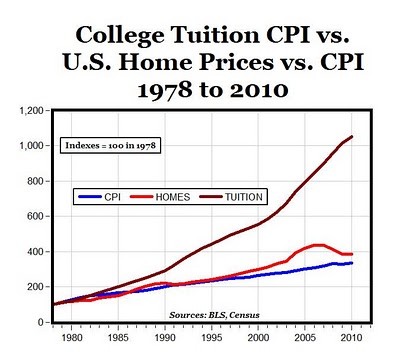
Student loans are skyrocketing--yes, America, we have a growth industry and it's called debt-serfdom. Debt serfdom is most effective when it starts young, so graduating with $100K in student loans and a couple thousand in high-interest credit card debt is the perfect start:
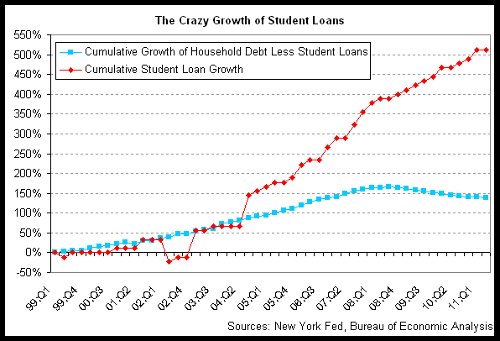
This is a chart from Zero Hedge drawn from a Federal Reserve spreadsheet:
Name The Bubble. Of related interest:
Student Loan Bubble To Exceed $1 Trillion: "It's Going To Create A Generation Of Wage Slavery" And Another Taxpayer Bailout.
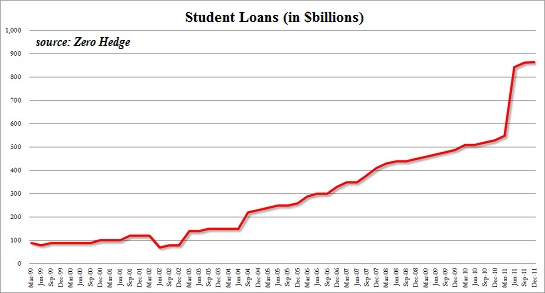
Though we pretend a college degree promises a middle-class income, the reality is somewhat less rosy: earnings are flat to stagnant. Since about 30% of the workforce has a college degree now, the "edge" provided by a diploma has dulled considerably. It's supply and demand: the supply of those with college degrees exceeds the demand.
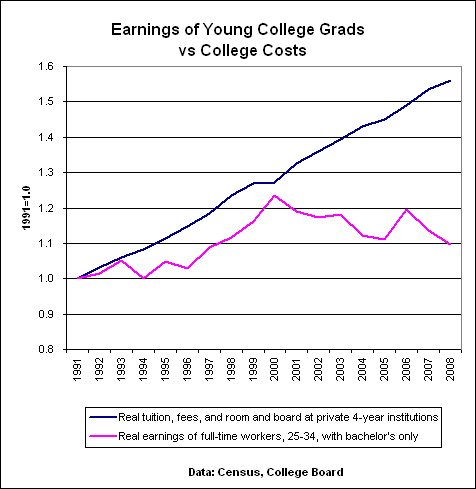
Student loans enable young people to "stay in school" or "go back to school". Waiting for the economy to pick up may or may not be a good strategy, but piling up debt to do so is a horrendously bad strategy--yet it is the one we enable and encourage.
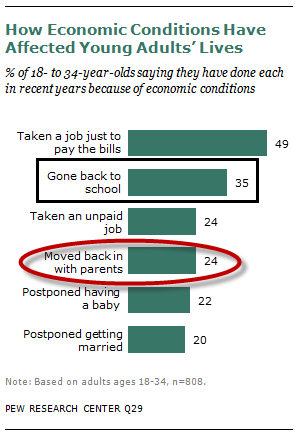
Here's a snapshot of the employment picture. The bogus "unemployment" rate can drop to zero but that won't mean more jobs are being created.
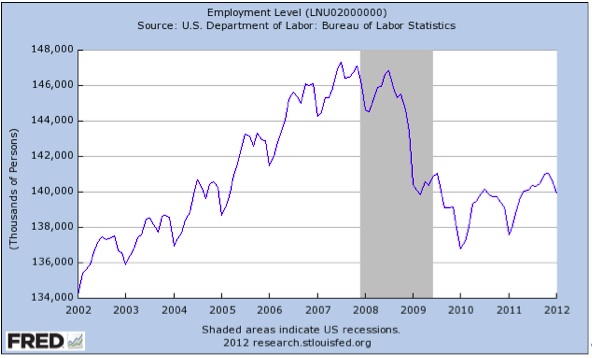
The "engine of growth," small business, is in a tailspin. Gee, could it have anything to do with the supremacy of crony-cartel capitalism, over-regulation imposed by the Central State and local government, and skyrocketing healthcare costs?
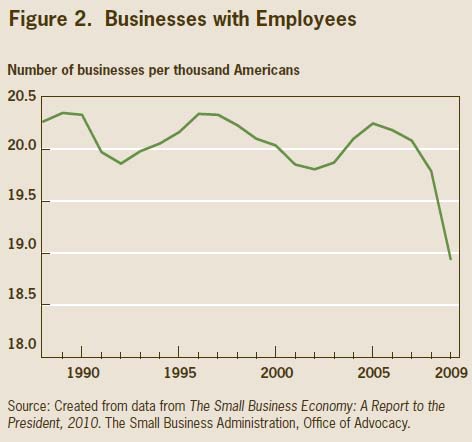
Here's the reality. Large global firms, i.e. corporations, have been the major source of job creation in recent years. But due to a number of thorny issues such as skyrocketing costs of sickcare insurance in the U.S. and the need to develop resources within overseas markets, global companies are hiring overseas, not in the U.S., except for those with high-level experience in specific computer-software skillsets.
Even having a computer science degree isn't enough any more; employers want years of experience with a suite of software tools and they would rather poach an experienced coder from a competitor than go through the trouble of training a FOOS (fresh out of school CS major.
The truly pathetic part of the student loan scam is that is often the only State funding available to marginalized populations. Here is an on-the-ground report from Dr. M.H., who serves the woefully under-served segment of the populace with severe mental health and poverty issues:
An amazingly large portion of my patients ( drug and alcohol addicted and the psychiatrically ill are fleeing into student loans and grants to escape homelessness.
I even have previously middle-class patients ( many with previously missed "soft" bipolar illness which has got them into deep trouble due to depression and impulsiveness , some in their sixties, who are taking this route for want of any plausible alternative.
Student loans are a $1 trillion "business." Here is a "
clock" of student debt.
$1 trillion is equivalent to the external (national debt of Canada. (
List of countries by external debt. So let's pretend that loading up our students and future taxpayers with a debt load equivalent to that of an entire nation is an excellent strategy for furthering future growth and education.
What that $1 trillion does further is profits and debt serfdom. Here are a few other resources to review:
The $1 trillion student loan market begins to implode Department of Education shows two-year default rates at for-profit colleges up to 15 percent. Student loan debt increasing at a rate of $170,000 per minute.
Grading Student Loans (Federal Reserve Bank of New York
35 Shocking Facts That Prove That College Education Has Become A Giant Money Making Scam
statement. “The coloring is completely cosmetic, adding nothing to the flavor of the product. During the chemical analyses, CSPI collected samples of Coca-Cola, Pepsi-Cola, Diet Coke, Diet Pepsi, Dr Pepper, Diet Dr Pepper, and Whole Foods 365 Cola from Washington D.C.-area stores. The group said Pepsi's products had 145- to 153-micrograms (mcg of 4-MI in two 12-ounce cans, while Coca-Cola had between 142- to 146- mcg per 12 ounces in the samples. The state of California has a 29-microgram limit for 4-MI, and drinks that exceed this number may be required to bear a warning notice. CSPI estimates that Coke and Pepsi products have caused about 15,000 cancers in the U.S. "If companies can make brown food coloring that is carcinogen-free, the industry should use that," Jacobson said. "And industry seems to be moving in that direction. Otherwise, the FDA needs to protect consumers from this risk by banning the coloring.” CSPI said the FDA has an exception for contaminants of food additives if it only causes a risk of one cancer in one million people. However, even Dr. Pepper and Diet Dr. Pepper having low levels of 4-MI, about 10 mcg per 12 ounces, pose a cancer risk of seven in one million. "Colorings made with the ammonia or ammonia-sulfite process contain carcinogens and don’t belong in the food supply," Jacobson said. "In any event, they shouldn’t be obscured by such an innocuous-sounding name as ‘caramel coloring." --- On the Net:
No comments:
Post a Comment